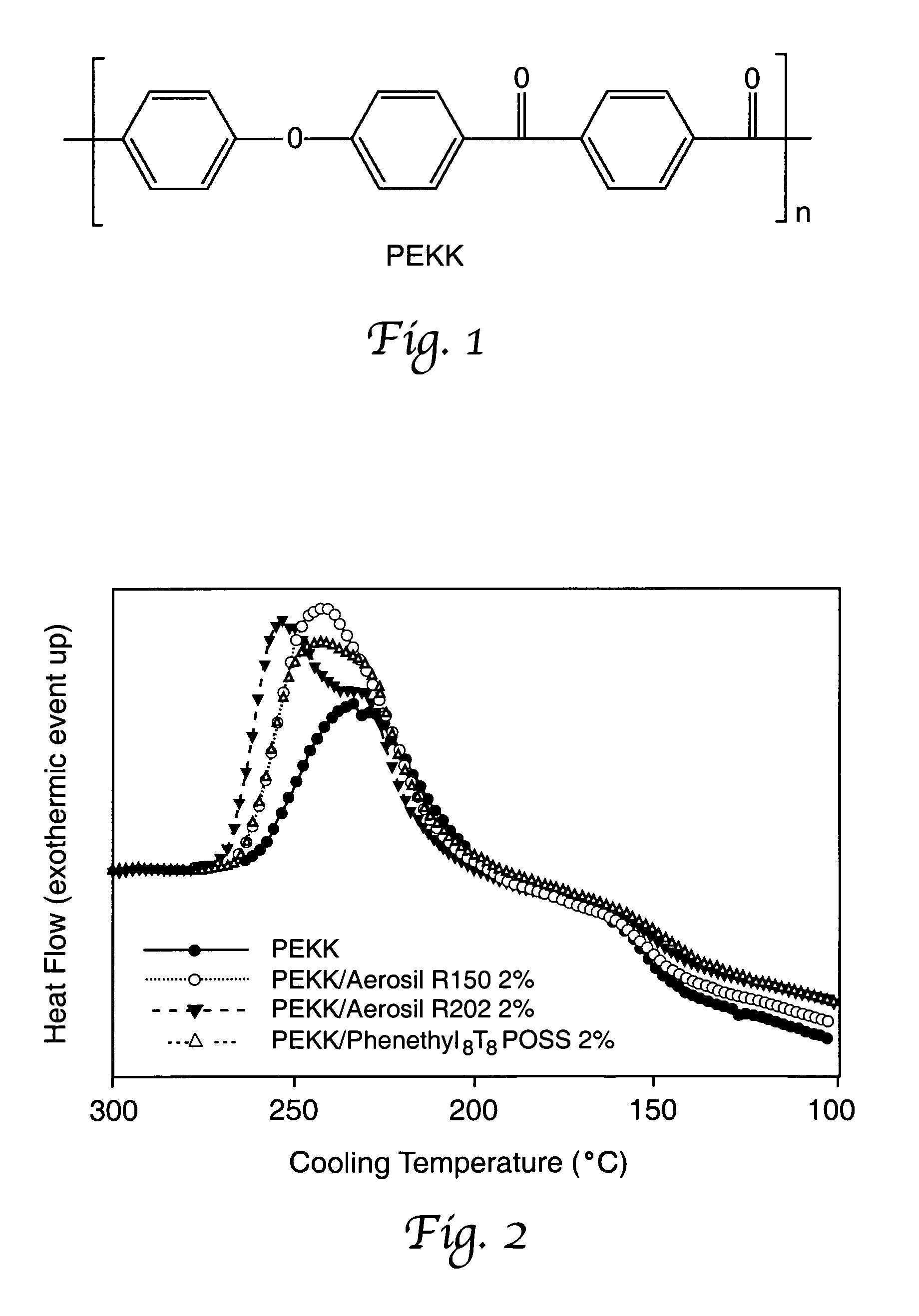Increasing the rate of crystallization of engineering thermoplastics
a technology of engineering thermoplastics and crystallization rate, which is applied in the field of improving can solve the problems of less than optimal mechanical properties of the ultimate composite, relatively low volume of polymers produced, and high cost compared to aliphatic thermoplastics, etc., and achieves the effect of accelerating enhancing the crystallization rate of engineering thermoplastics
- Summary
- Abstract
- Description
- Claims
- Application Information
AI Technical Summary
Benefits of technology
Problems solved by technology
Method used
Image
Examples
example 1
Example 1a
[0032]Poly(ether-ketone-ketone) in powder form, its chemical structure depicted in FIG. 1, was dry blended with one to ten weight percent of one of either two types of fumed silica provided by Degussa, grades Aerosil R150 (no surface treatment, hydrophilic) and Aerosil R202 (surface treated with polydimethylsiloxane, hydrophobic), both of elementary average particle size of 14 nm. A DSM twin screw batch mixer was employed to perform the melt compounding under a nitrogen atmosphere with all temperature zones set to a flat profile of 340° C., above the equilibrium melting point of the subject grade of PEKK. The powder blend was charged to the mixer imposing a residence time of five minutes after which the material was extruded in the form of strands for differential scanning calorimetry (DSC) measurement. DSC measures the heat flow required to maintain a polymer sample's temperature identical to that of an empty control cell and is useful for analyzing polymer t...
example 1b
[0033]Following the same procedure outlined in Example 1a, POSS is incorporated into PEKK. POSS consists of an inorganic cage-type core of silicon and oxygen at a ration of 1:1.5, covalently surrounded by an organic periphery that may be tailored for target host polymer compatibility. In this case, [C8H9SiO1.5]8, alternatively known as phenethyl8T8POSS is utilized as it demonstrates a succinct melting point of 80° C. introducing the possibility of achieving a nano-scale level of dispersion in the polymer host. The chemical structure of this version of POSS is shown in FIG. 7 where Ph designates a phenyl moiety. It should be highlighted that many inert commercially available versions of POSS are marketed in a crystallized form with average particle sizes on the order of tens of microns. As these crystallites are bound by very strong molecular forces, they tend to degrade before they melt and thus cannot be dispersed down to their elementary particle size in polymer hosts. Thus, [C8H9...
example 2
Solution Blending
Example 2a
[0034]Poly(ether-ketone-ketone) and [C8H9SiO1.5]8, at two to ten weight percent of the overall mass of the composition, were weighed in a vial. A common solvent for the two components, namely pentafluorophenol, was added until the overall solute concentration was 20 percent. The mixture was magnetically stirred at 120° C. using a hot plate until complete solute dissolution. The pentafluorophenol was subsequently recovered through distillation above the glass transition temperature of the engineering thermoplastic. The resultant solute was subsequently dried overnight in a vacuum oven at 70° C.
PUM
| Property | Measurement | Unit |
|---|---|---|
| melting point | aaaaa | aaaaa |
| particle size | aaaaa | aaaaa |
| equilibrium melting point | aaaaa | aaaaa |
Abstract
Description
Claims
Application Information
 Login to View More
Login to View More - R&D
- Intellectual Property
- Life Sciences
- Materials
- Tech Scout
- Unparalleled Data Quality
- Higher Quality Content
- 60% Fewer Hallucinations
Browse by: Latest US Patents, China's latest patents, Technical Efficacy Thesaurus, Application Domain, Technology Topic, Popular Technical Reports.
© 2025 PatSnap. All rights reserved.Legal|Privacy policy|Modern Slavery Act Transparency Statement|Sitemap|About US| Contact US: help@patsnap.com



